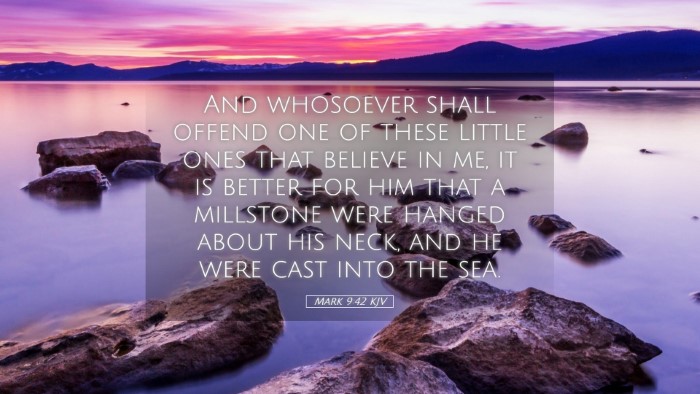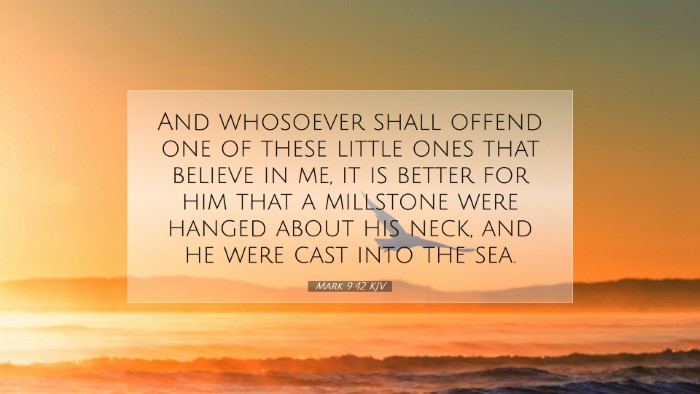Commentary on Mark 9:42
Verse: Mark 9:42 - "And whosoever shall offend one of these little ones that believe in me, it is better for him that a millstone were hanged about his neck, and he were cast into the sea."
This verse serves as a solemn warning concerning the spiritual dangers posed to those who lead others, particularly vulnerable believers, into sin or spiritual harm. Let us explore the insights from various public domain commentaries to better understand its implications.
Introduction
In this passage, Jesus speaks of the severe consequences awaiting those who cause others, especially "little ones," to stumble in their faith. The term "little ones" can be interpreted as referring to children, those new to faith, or the humble believers within the community. The seriousness of such offenses is underscored by the drastic metaphor of a millstone, emphasizing the weight of responsibility held by those in the faith community.
Matthew Henry's Commentary
Matthew Henry highlights the significance of leading others into sin, particularly the innocent and vulnerable. He emphasizes that:
- The Importance of Discipleship: Discipleship is a weighty responsibility that must be approached with care. Leading others astray, especially those who are fragile in faith, incurs grave consequences.
- The Severity of the Judgment: Henry points out that the illustration of a millstone— traditionally used for grinding grain— symbolizes the heavy punishment fitting for such offenders. The vivid imagery illustrates that a fate such as being cast into the sea with a millstone is a representation of divine justice.
- The Value of the Innocent: There is an inherent value in the faith and innocence of children and new believers, and to corrupt that is a serious offense in the eyes of God.
Albert Barnes' Notes
Albert Barnes provides further illumination on the context and theological implications of this verse:
- The Nature of "Offending": According to Barnes, to "offend" in this context means to cause someone to sin or to put them in a position where they might fall away from their faith. This extends not just to children, but to anyone who holds a sincere belief in Christ.
- The Graphic Metaphor: Barnes elaborates on Jesus’ choice of metaphor— a millstone—which signifies a complete and dreadful fate for those who lead others astray. This metaphor encapsulates the notion of an irreversible consequence stemming from one’s actions.
- The Broader Community Impact: He emphasizes that the influence of one believer can affect others significantly. Hence, one person's sin can lead to communal repercussions, underscoring the interconnectedness of the Christian community.
Adam Clarke's Commentary
Adam Clarke offers a reflective analysis on the implications of this teaching:
- Spiritual Responsibility: Clarke underscores that spiritual leaders carry an immense burden of responsibility. Their actions can either uplift or undermine the faith of those they lead.
- The Metaphor’s Weight: He examines the cultural significance of the millstone, noting that it was a common tool and therefore relatable to Jesus’ audience. The weight of a millstone hanged around a person's neck represents the profound nature of the consequences for those who offend.
- Christ's Care for the Weak: Clarke emphasizes Christ's heart for the weak and marginalized in society, exemplifying God's concern for the "little ones." This reflects an overarching theme of love and protection extended to those in need.
Theological Implications
This verse affirms several theological principles crucial for understanding the nature of sin, responsibility, and community in the Christian life:
- The Gravity of Sin Against the Innocent: Offending the innocent is treated with extreme seriousness, reminding the believers of the sanctity and the impacted state of faith of vulnerable individuals.
- Divine Accountability: There exists a principle of accountability where those with influence in faith communities bear the weight of their actions, especially regarding their impact on others' faith journeys.
- The Importance of Community Integrity: The collective integrity of the body of Christ is highlighted, promoting an environment that nurtures, rather than harms the faith of others.
Practical Application
As pastors, students, and scholars reflect on this passage, several practical applications arise:
- Evaluate Influence: Conduct a self-examination of the influence one holds over others, consciously making efforts to lead faithfully and prevent others from stumbling.
- Encourage the Vulnerable: Create a church culture that protects and uplifts those who may be weaker in faith, ensuring they are encouraged and nurtured.
- Teach Accountability: Foster teachings on mutual accountability within the church body, where members support each other in striving toward holiness and righteousness.
Conclusion
Mark 9:42 serves as a critical reminder of the responsibilities that come with faith leadership. The insights drawn from Matthew Henry, Albert Barnes, and Adam Clarke reveal a shared understanding of the weightiness of causing others to stumble and the value of nurturing faith. Believers are called to lead with integrity, love, and care, ensuring the community remains a supportive foundation for all, especially the vulnerable.


